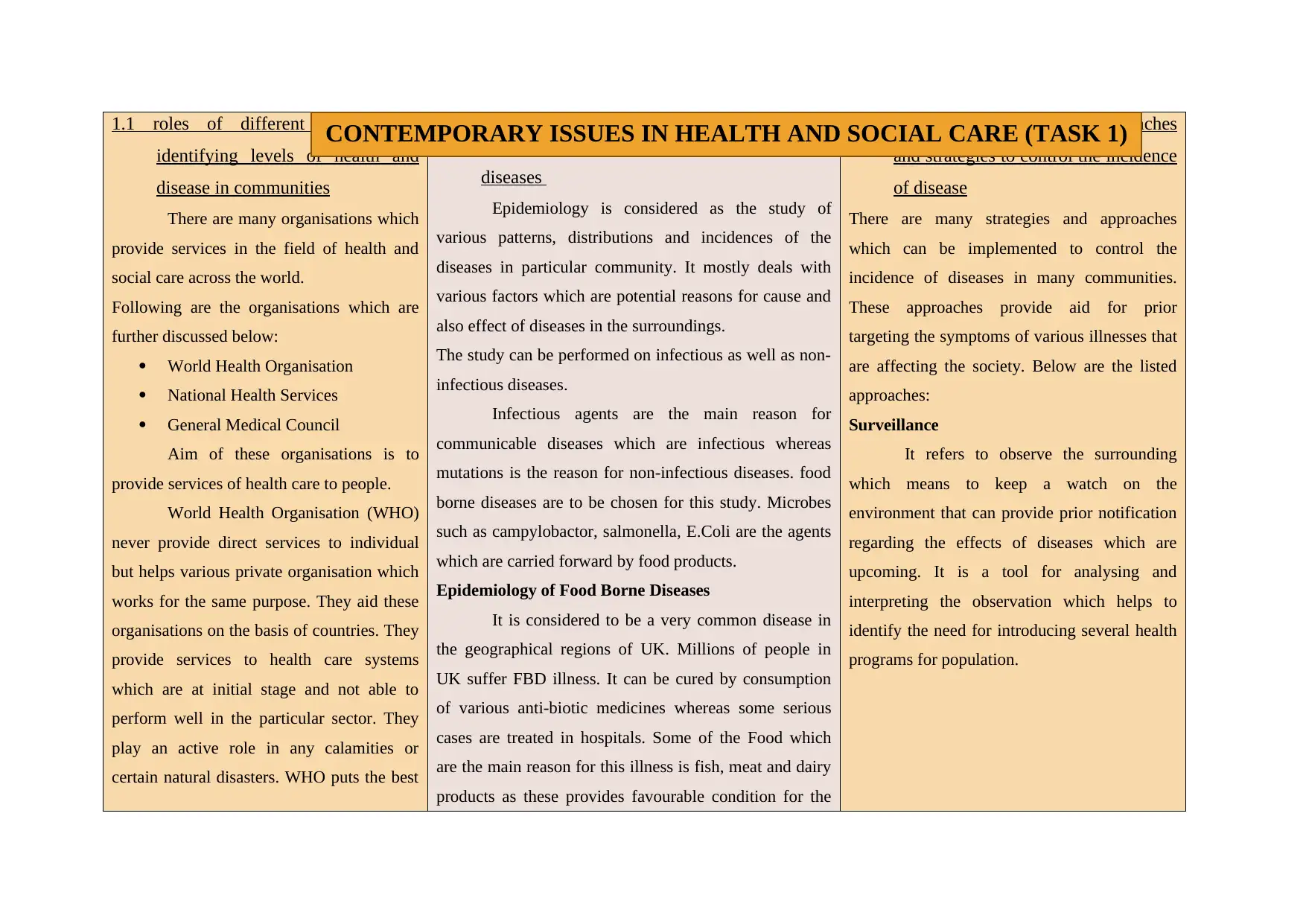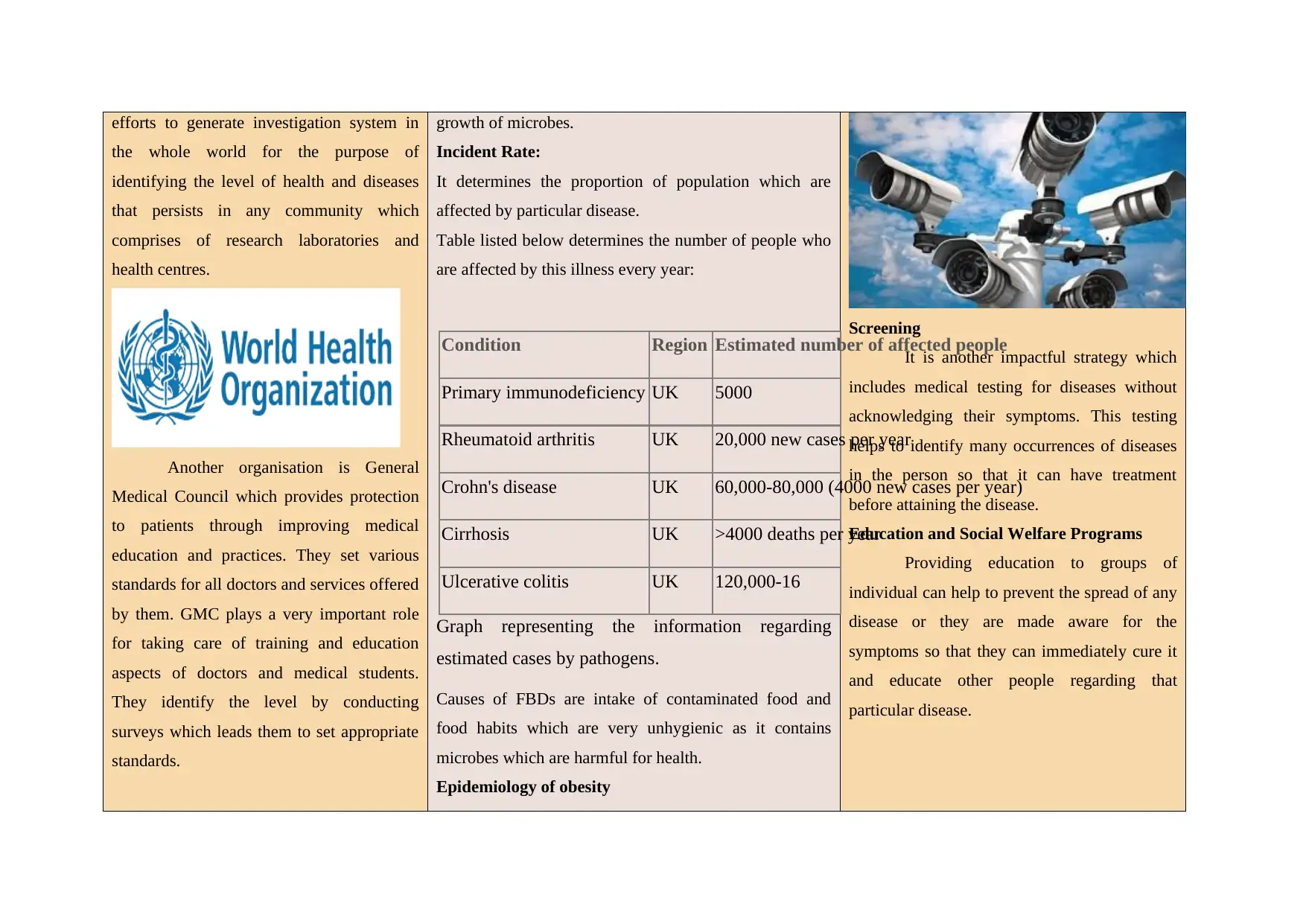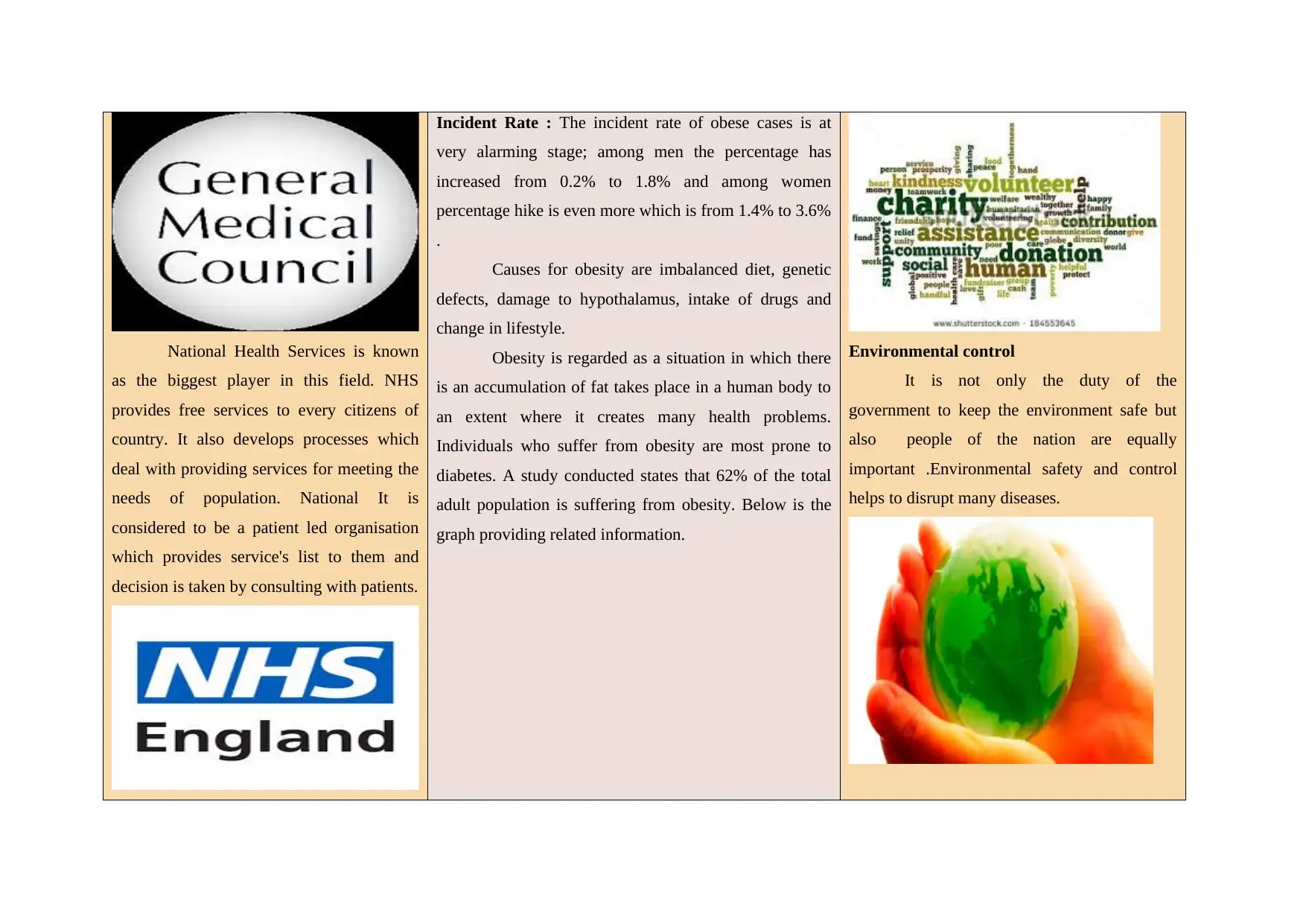Analysis of Health and Social Care Agencies and Disease Control
VerifiedAdded on 2020/06/05
|3
|982
|90
Report
AI Summary
This report delves into contemporary issues in health and social care, beginning with an examination of the roles played by various agencies such as the World Health Organization (WHO), National Health Services (NHS), and General Medical Council (GMC) in identifying levels of health and disease within communities. The report then explores the epidemiology of both infectious and non-infectious diseases, specifically focusing on foodborne diseases and obesity, including incident rates and causal factors. Finally, it evaluates the effectiveness of different approaches and strategies for controlling the incidence of diseases, such as surveillance, screening, education, and environmental control measures. The report provides insights into the complexities of public health management and disease prevention, highlighting the importance of multifaceted strategies to address health challenges.

1.1 roles of different agencies in
identifying levels of health and
disease in communities
There are many organisations which
provide services in the field of health and
social care across the world.
Following are the organisations which are
further discussed below:
World Health Organisation
National Health Services
General Medical Council
Aim of these organisations is to
provide services of health care to people.
World Health Organisation (WHO)
never provide direct services to individual
but helps various private organisation which
works for the same purpose. They aid these
organisations on the basis of countries. They
provide services to health care systems
which are at initial stage and not able to
perform well in the particular sector. They
play an active role in any calamities or
certain natural disasters. WHO puts the best
1.2 Epidemiology of infectious and non-infectious
diseases
Epidemiology is considered as the study of
various patterns, distributions and incidences of the
diseases in particular community. It mostly deals with
various factors which are potential reasons for cause and
also effect of diseases in the surroundings.
The study can be performed on infectious as well as non-
infectious diseases.
Infectious agents are the main reason for
communicable diseases which are infectious whereas
mutations is the reason for non-infectious diseases. food
borne diseases are to be chosen for this study. Microbes
such as campylobactor, salmonella, E.Coli are the agents
which are carried forward by food products.
Epidemiology of Food Borne Diseases
It is considered to be a very common disease in
the geographical regions of UK. Millions of people in
UK suffer FBD illness. It can be cured by consumption
of various anti-biotic medicines whereas some serious
cases are treated in hospitals. Some of the Food which
are the main reason for this illness is fish, meat and dairy
products as these provides favourable condition for the
1.3 Effectiveness of different approaches
and strategies to control the incidence
of disease
There are many strategies and approaches
which can be implemented to control the
incidence of diseases in many communities.
These approaches provide aid for prior
targeting the symptoms of various illnesses that
are affecting the society. Below are the listed
approaches:
Surveillance
It refers to observe the surrounding
which means to keep a watch on the
environment that can provide prior notification
regarding the effects of diseases which are
upcoming. It is a tool for analysing and
interpreting the observation which helps to
identify the need for introducing several health
programs for population.
CONTEMPORARY ISSUES IN HEALTH AND SOCIAL CARE (TASK 1)
identifying levels of health and
disease in communities
There are many organisations which
provide services in the field of health and
social care across the world.
Following are the organisations which are
further discussed below:
World Health Organisation
National Health Services
General Medical Council
Aim of these organisations is to
provide services of health care to people.
World Health Organisation (WHO)
never provide direct services to individual
but helps various private organisation which
works for the same purpose. They aid these
organisations on the basis of countries. They
provide services to health care systems
which are at initial stage and not able to
perform well in the particular sector. They
play an active role in any calamities or
certain natural disasters. WHO puts the best
1.2 Epidemiology of infectious and non-infectious
diseases
Epidemiology is considered as the study of
various patterns, distributions and incidences of the
diseases in particular community. It mostly deals with
various factors which are potential reasons for cause and
also effect of diseases in the surroundings.
The study can be performed on infectious as well as non-
infectious diseases.
Infectious agents are the main reason for
communicable diseases which are infectious whereas
mutations is the reason for non-infectious diseases. food
borne diseases are to be chosen for this study. Microbes
such as campylobactor, salmonella, E.Coli are the agents
which are carried forward by food products.
Epidemiology of Food Borne Diseases
It is considered to be a very common disease in
the geographical regions of UK. Millions of people in
UK suffer FBD illness. It can be cured by consumption
of various anti-biotic medicines whereas some serious
cases are treated in hospitals. Some of the Food which
are the main reason for this illness is fish, meat and dairy
products as these provides favourable condition for the
1.3 Effectiveness of different approaches
and strategies to control the incidence
of disease
There are many strategies and approaches
which can be implemented to control the
incidence of diseases in many communities.
These approaches provide aid for prior
targeting the symptoms of various illnesses that
are affecting the society. Below are the listed
approaches:
Surveillance
It refers to observe the surrounding
which means to keep a watch on the
environment that can provide prior notification
regarding the effects of diseases which are
upcoming. It is a tool for analysing and
interpreting the observation which helps to
identify the need for introducing several health
programs for population.
CONTEMPORARY ISSUES IN HEALTH AND SOCIAL CARE (TASK 1)
Paraphrase This Document
Need a fresh take? Get an instant paraphrase of this document with our AI Paraphraser

efforts to generate investigation system in
the whole world for the purpose of
identifying the level of health and diseases
that persists in any community which
comprises of research laboratories and
health centres.
Another organisation is General
Medical Council which provides protection
to patients through improving medical
education and practices. They set various
standards for all doctors and services offered
by them. GMC plays a very important role
for taking care of training and education
aspects of doctors and medical students.
They identify the level by conducting
surveys which leads them to set appropriate
standards.
growth of microbes.
Incident Rate:
It determines the proportion of population which are
affected by particular disease.
Table listed below determines the number of people who
are affected by this illness every year:
Condition Region Estimated number of affected people
Primary immunodeficiency UK 5000
Rheumatoid arthritis UK 20,000 new cases per year
Crohn's disease UK 60,000-80,000 (4000 new cases per year)
Cirrhosis UK >4000 deaths per year
Ulcerative colitis UK 120,000-16
Graph representing the information regarding
estimated cases by pathogens.
Causes of FBDs are intake of contaminated food and
food habits which are very unhygienic as it contains
microbes which are harmful for health.
Epidemiology of obesity
Screening
It is another impactful strategy which
includes medical testing for diseases without
acknowledging their symptoms. This testing
helps to identify many occurrences of diseases
in the person so that it can have treatment
before attaining the disease.
Education and Social Welfare Programs
Providing education to groups of
individual can help to prevent the spread of any
disease or they are made aware for the
symptoms so that they can immediately cure it
and educate other people regarding that
particular disease.
the whole world for the purpose of
identifying the level of health and diseases
that persists in any community which
comprises of research laboratories and
health centres.
Another organisation is General
Medical Council which provides protection
to patients through improving medical
education and practices. They set various
standards for all doctors and services offered
by them. GMC plays a very important role
for taking care of training and education
aspects of doctors and medical students.
They identify the level by conducting
surveys which leads them to set appropriate
standards.
growth of microbes.
Incident Rate:
It determines the proportion of population which are
affected by particular disease.
Table listed below determines the number of people who
are affected by this illness every year:
Condition Region Estimated number of affected people
Primary immunodeficiency UK 5000
Rheumatoid arthritis UK 20,000 new cases per year
Crohn's disease UK 60,000-80,000 (4000 new cases per year)
Cirrhosis UK >4000 deaths per year
Ulcerative colitis UK 120,000-16
Graph representing the information regarding
estimated cases by pathogens.
Causes of FBDs are intake of contaminated food and
food habits which are very unhygienic as it contains
microbes which are harmful for health.
Epidemiology of obesity
Screening
It is another impactful strategy which
includes medical testing for diseases without
acknowledging their symptoms. This testing
helps to identify many occurrences of diseases
in the person so that it can have treatment
before attaining the disease.
Education and Social Welfare Programs
Providing education to groups of
individual can help to prevent the spread of any
disease or they are made aware for the
symptoms so that they can immediately cure it
and educate other people regarding that
particular disease.

National Health Services is known
as the biggest player in this field. NHS
provides free services to every citizens of
country. It also develops processes which
deal with providing services for meeting the
needs of population. National It is
considered to be a patient led organisation
which provides service's list to them and
decision is taken by consulting with patients.
Incident Rate : The incident rate of obese cases is at
very alarming stage; among men the percentage has
increased from 0.2% to 1.8% and among women
percentage hike is even more which is from 1.4% to 3.6%
.
Causes for obesity are imbalanced diet, genetic
defects, damage to hypothalamus, intake of drugs and
change in lifestyle.
Obesity is regarded as a situation in which there
is an accumulation of fat takes place in a human body to
an extent where it creates many health problems.
Individuals who suffer from obesity are most prone to
diabetes. A study conducted states that 62% of the total
adult population is suffering from obesity. Below is the
graph providing related information.
Environmental control
It is not only the duty of the
government to keep the environment safe but
also people of the nation are equally
important .Environmental safety and control
helps to disrupt many diseases.
as the biggest player in this field. NHS
provides free services to every citizens of
country. It also develops processes which
deal with providing services for meeting the
needs of population. National It is
considered to be a patient led organisation
which provides service's list to them and
decision is taken by consulting with patients.
Incident Rate : The incident rate of obese cases is at
very alarming stage; among men the percentage has
increased from 0.2% to 1.8% and among women
percentage hike is even more which is from 1.4% to 3.6%
.
Causes for obesity are imbalanced diet, genetic
defects, damage to hypothalamus, intake of drugs and
change in lifestyle.
Obesity is regarded as a situation in which there
is an accumulation of fat takes place in a human body to
an extent where it creates many health problems.
Individuals who suffer from obesity are most prone to
diabetes. A study conducted states that 62% of the total
adult population is suffering from obesity. Below is the
graph providing related information.
Environmental control
It is not only the duty of the
government to keep the environment safe but
also people of the nation are equally
important .Environmental safety and control
helps to disrupt many diseases.
⊘ This is a preview!⊘
Do you want full access?
Subscribe today to unlock all pages.

Trusted by 1+ million students worldwide
1 out of 3
Related Documents
Your All-in-One AI-Powered Toolkit for Academic Success.
+13062052269
info@desklib.com
Available 24*7 on WhatsApp / Email
![[object Object]](/_next/static/media/star-bottom.7253800d.svg)
Unlock your academic potential
Copyright © 2020–2025 A2Z Services. All Rights Reserved. Developed and managed by ZUCOL.





